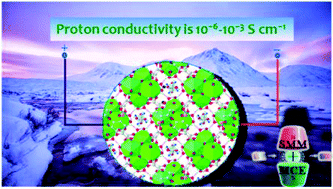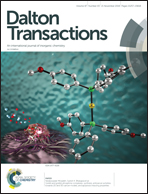3D isomorphous lanthanide coordination polymers displaying magnetic refrigeration, slow magnetic relaxation and tunable proton conduction†
Abstract
Four new isostructural lanthanide-based three-dimensional (3D) coordination polymers (CPs), {[Ln4(OH)4(L)2(H2O)8]·4.6H2O·1.4CH3CN}n (Ln3+ = Gd3+ (1), Dy3+ (2), Ho3+ (3) and Er3+ (4)), have been constructed using a sulfonate–carboxylate-based ligand (Na2H2L = disodium-2,2′-disulfonate-4,4′-oxydibenzoic acid) and the corresponding lanthanide metal(III) nitrates. All the CPs 1–4 contain [Ln4(μ3-OH)4]8+ cubane-like cores interconnected through L4− ligands to give rise to 3D coordination frameworks with 1D hydrophilic channels along the crystallographic c direction. From the topological perspective, the underlying 3D nets of the CPs can be classified as a 3,6,6-c net with an undocumented topology. Magnetic studies display that CP 1 exhibits a magnetocaloric effect with a significant magnetic entropy change (−ΔSm) = 34.6 J kg−1 K−1 for ΔH = 7 T at 3 K. CP 2 shows field-induced slow magnetic relaxation properties with energy barrier (Ueff/kB) = 30.40 K and relaxation time (τ0) = 2.47 × 10−7 s. Theoretical calculations have been performed to corroborate the magnetic exchange coupling constant value for CP 1 and to obtain a deeper understanding of the field-induced slow magnetic relaxation behavior of CP 2. Impedance analyses display high values of proton conductivity which reach 2.02 × 10−6, 2.96 × 10−6, 4.56 × 10−3 and 6.59 × 10−3 S cm−1 for CPs 1–4, respectively at high temperature (>75 °C) and 95% relative humidity (RH) in the order CP 1 < CP 2 < CP 3 < CP 4. Notably, the proton conductivities for CPs 3 and 4 are a few orders of magnitude higher than those of CPs 1 and 2 (10−3 S cm−1vs. 10−6 S cm−1), and the conductivity increases periodically following the decreasing order of ionic radius (Gd3+ > Dy3+ > Ho3+ > Er3+). This demonstrates the effective employment of the lanthanide contraction strategy to tune proton conductivity while preserving proton-conducting pathways.

- This article is part of the themed collection: New Talent: Asia-Pacific


 Please wait while we load your content...
Please wait while we load your content...